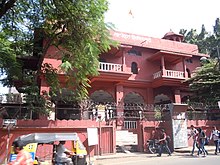Lal Mahal

TheLal Mahal(Red Palace) of Pune is one of the most famous monuments located inPune,India,whereShivaji I,founder of theMaratha Empirespent his childhood.[1]
History Of Lal Mahal
[edit]In the year 1630 AD, Shivaji's FatherShahaji,established the Lal Mahal for his wifeJijabaiand son.Chhatrapati Shivaji Maharaj stayed here for many years till he captured the first fort. The current Lal Mahal is a reconstruction of the original and located in the center of the Pune city. The original Lal Mahal was built with the idea of rejuvenating the recently razed city of Pune when Shahaji Raje entered the city along with Shivaji and his mother, Maasaheb Jijabai. Young Shivaji grew up here, and stayed in the Lal Mahal till he captured theTornafort in 1645. Shivaji's marriage with his first wife,Saibaitook place in Lal Mahal on 16 May 1640.[2][3]
The Lal Mahal is also famous for an encounter between Shivaji andShaista Khanwhere Shivaji cut off four fingers of the latter's when he was trying to escape from the first-floor window of the Lal Mahal.[4]This was part of a surreptitiousguerrilla attackon the massive and entrenchedMughal Armythat had camped in Pune, with Shaista occupying (possibly symbolically) Shivaji's childhood home. As a punishment for the ignominy of the defeat despite superior numbers and better armed and fed soldiers, Shaista was transferred by theMughal EmperorAurangzebtoBengal.[5]
Towards the end of the 17th Century, the Lal Mahal was ruined by some people and was eventually razed to the ground as a result of various attacks on the city.[6]It is said that during the construction of theShaniwarwada,some soil and stones of the Lal Mahal were used for luck. In 1734-35, a few houses were constructed on the land of the Lal Mahal and given for use toRanoji Shindeand Ramchandraji. The records in the offices of thePeshwasmention that Lal Mahal was used for arranging feasts for theBrahminsduring thethread-ceremonyofSadashivrao Bhau,son ofChimaji Appa.The exact original location of the Lal Mahal is unknown, however, it was known to be very close to the location of Shaniwarwada, which is roughly where the current reconstruction stands.
Reconstruction and current structure
[edit]The current Lal Mahal was built only on a part of the land of the original Lal Mahal. The new Lal Mahal was not rebuilt in the same fashion as the original one and there is not much information found about the area and structure of the original Lal Mahal. The current Lal Mahal was rebuilt by thePune Municipal Corporation.Construction started in 1984 and was completed in 1988.[7]
The current Lal Mahal is a memorial holding a collection of large-size oil paintings based on the significant events in the life of Shivaji, a statue of Jijabai, a carving depicting Shivaji using a gold plow along with Jijabai, a fiber model ofRaigadwith horsemen and a huge map of Maharashtra indicating the forts of Shivaji. The popular Jijamata Garden is now a recreational park for kids.[1]
See also
[edit]References
[edit]- ^ab"50 lakh makeover for Lal Mahal".Times of India.27 April 2016.
- ^Petlee, Peter (19 February 2017)."Chhatrapati Shivaji Maharaj's Bengaluru days".Times of India.
- ^Balkrishna Deopujari, Murlidhar (1973).Shivaji and the Maratha Art of War.Vidarbha Maharashtra Samshodhan Mandal. p. 35.
- ^"Lal Mahal".Government of Maharashtra.
- ^Chandra, Satish (2007).History of medieval India: 800 - 1700(1. publ ed.). New Delhi: Orient Longman.ISBN978-81-250-3226-7.OCLC191849214.
- ^"Will razed Lal Mahal rise from the rubble? - Times of India".articles.timesofindia.indiatimes.com.Archived fromthe originalon 9 June 2012.Retrieved17 January2022.
- ^"Pune Municipal Corporation plans to spend Rs 75 lakh on renovation of Lal Mahal".Indian Express.18 August 2018.

